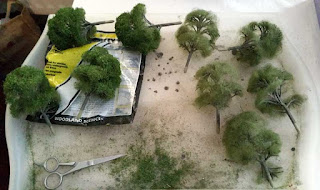Hello Folks.
Wow, was it really October last year when I made my last blog post? Doesnt time fly when you get on with things. With many of my other projects, enthusiasm comes and goes, thoughts appear and ideas are tested. To be honest the vast majority of the time it doesnt feel like I have enough to warrant a blog posting so instead of waffling on about nothing in particular I do try to save up things a bit to hopefully make the blog posts interesting.
So, what have I been upto since my last blog post I hear you all ask? Here is a summary of the bits and bobs I have been playing with, it might be interesting to some? I really hope at least a single person gets some inspiration from it all...
1. GWR 22xx
This has been a project that has been ongoing for a bit now. I restarted it over the Christmas break as the layout was once again packed away for the festivities. As per pretty much all my projects the starting point was a scale drawing which was then added into AutoCad where the size, shape, and gearing was worked out. In the particular case of these engines the CAD drawings were then imported into Inventor (my 3D package of choice) where I have a nice little plugin that converts the 3D into G code ready for my CNC.
This is the setup. As you might realise from the majority of my photos my workbench is basically my PC table so when the machines are out the PC takes second priority.
This is an image of the CNC chopping up some PCB material. In this instance its a sideframe for one of the tender chassis. The cutter is a 1mm diameter Carbide slot drill (for those who are interested!
Once all the bits I need are cut out its then a case of soldering the bits together as per a etched chassis. They are accurate enough not to be reliant upon the axle holes to line everything up.
This is the resultant of the tender bits an bobs to date. The motor is a 2MMSA component. These two chassis are destined for a dapol 22xx tender body.
And this is one of the chassis to date. There is still lots to do which I work through once I have figured out what to do. Its the first tender engine I have built replacement chassis for so there are new challenges for me. I have designed a little bracket on the engine that means the worm can be easily removed if needed, to me its an essential part of a chassis.
2. Q1
I have decided to remake the wheels for my converted Dapol Q1 engine. The originals didnt run as concentric and wobble free as I would have liked so I have made a start on a new design.
The first part of the idea was to turn up some wheel blanks which use standard 2mmSA wheel rims. The blanks are made from a Paxolin type of material bought on Ebay, the rims are glued into position with a spot of loctite.
These are the blanks to date ready for profiling. The three on the right are scrapped parts which didnt 'turn' out right (it happens) and as you might have noticed I have seven passable wheels so there is a spare just in case of future errors.
More will follow on this as I make progress.
3. Mamod
A bit of a curved ball this one but at a toyfair over the holidays I picked up this for the total sum of £35.
The original thought for this was to replace the chimney and lave it at that but of course its changed now. As my confidence with the machines I own is growing the ideas are starting to develop, so there are some small plans for this now. It doesn't involve making a chimney though, does anyone know where I can find one?
4. P.C.
OK, so not modelling but worth mentioning. Over the holidays I invested in a laptop PC. This is a departure for my as previously its always been a desktop PC. The BIG advantage is that I now have CAD-TO-GO and recently tested this out at the ST Albans show where I demonstrated my CAD work. It seemed to go down well so hopefully I will be doing more of this at shows in the future.
Right, I think thats this blog up to date now. Let me know what you think...
Julia :o)










































